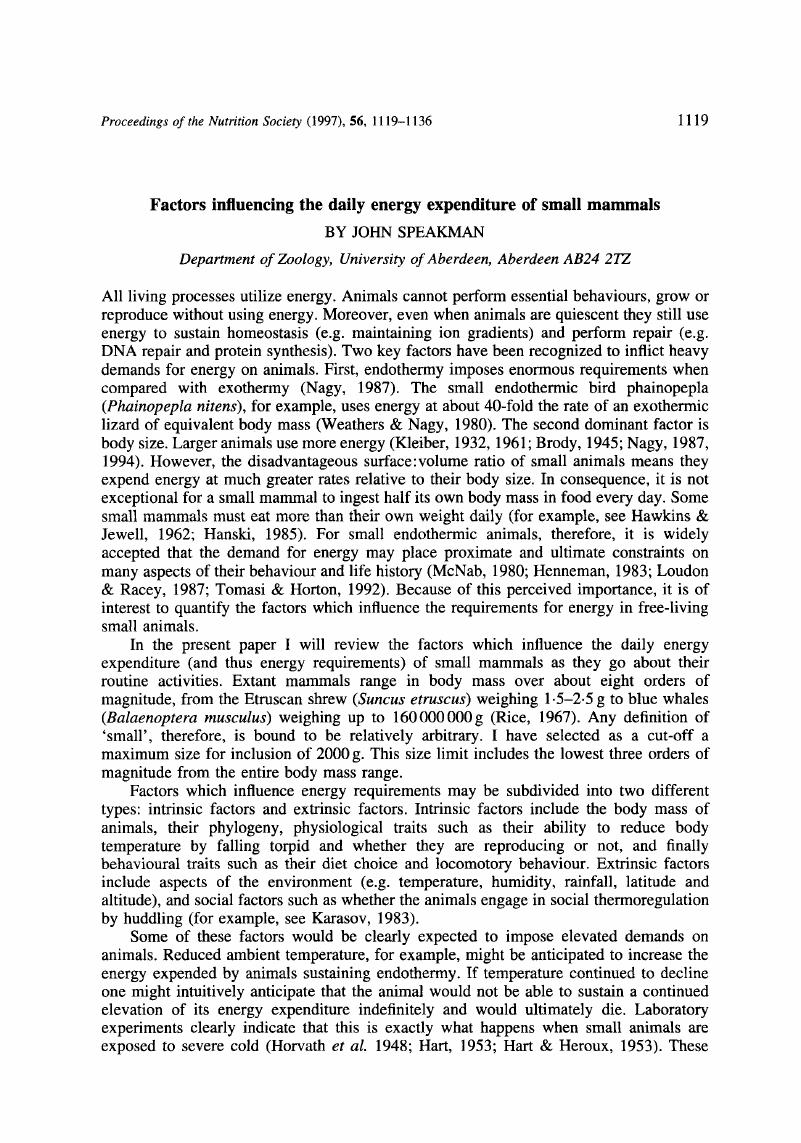Crossref Citations
This article has been cited by the following publications. This list is generated based on data provided by Crossref.
Corp, N.
Gorman, M. L.
and
Speakman, J. R.
1999.
Daily energy expenditure of free‐living male Wood Mice in different habitats and seasons.
Functional Ecology,
Vol. 13,
Issue. 5,
p.
585.
Speakman, J.R.
1999.
Advances in Ecological Research Volume 30.
Vol. 30,
Issue. ,
p.
177.
Nagy, K. A.
Girard, I. A.
and
Brown, T. K.
1999.
ENERGETICS OF FREE-RANGING MAMMALS, REPTILES, AND BIRDS.
Annual Review of Nutrition,
Vol. 19,
Issue. 1,
p.
247.
Scantlebury, Michael
Butterwick, Richard
and
Speakman, John R.
2001.
Energetics and litter size variation in domestic dog Canis familiaris breeds of two sizes.
Comparative Biochemistry and Physiology Part A: Molecular & Integrative Physiology,
Vol. 129,
Issue. 4,
p.
919.
Holt, William V.
Pickard, Amanda R.
Rodger, John C.
and
Wildt, David E.
2002.
Reproductive Science and Integrated Conservation.
p.
21.
McEvoy, Tom G.
and
Robinson, John J.
2002.
Reproductive Science and Integrated Conservation.
p.
42.
Spencer, K. A.
and
Bryant, D. M.
2002.
State–dependent behaviour in breeding barn swallows (
Hirundo rustica
): consequences for reproductive effort
.
Proceedings of the Royal Society of London. Series B: Biological Sciences,
Vol. 269,
Issue. 1489,
p.
403.
Génin, F.
Nibbelink, M.
Galand, M.
Perret, M.
and
Ambid, L.
2003.
Brown fat and nonshivering thermogenesis in the gray mouse lemur (Microcebus murinus).
American Journal of Physiology-Regulatory, Integrative and Comparative Physiology,
Vol. 284,
Issue. 3,
p.
R811.
Génin, F
and
Perret, M
2003.
Daily hypothermia in captive grey mouse lemurs (Microcebus murinus): effects of photoperiod and food restriction.
Comparative Biochemistry and Physiology Part B: Biochemistry and Molecular Biology,
Vol. 136,
Issue. 1,
p.
71.
Ergon, Torbjørn
Speakman, John R.
Scantlebury, Michael
Cavanagh, Rachel
and
Lambin, Xavier
2004.
Optimal Body Size and Energy Expenditure during Winter: Why Are Voles Smaller in Declining Populations?.
The American Naturalist,
Vol. 163,
Issue. 3,
p.
442.
Kokurewicz, Tomasz
2004.
Sex and Age Related Habitat Selection and Mass Dynamics of Daubenton's BatsMyotis daubentonii(Kuhl, 1817) Hibernating in Natural Conditions.
Acta Chiropterologica,
Vol. 6,
Issue. 1,
p.
121.
Boos, M.
Thouzeau, C.
Delacour, G.
Artois, M.
Marchandeau, S.
Jean-Claude, P.
and
Robin, J.-P.
2005.
Body condition assessment and prediction of fasting endurance in wild rabbits (Oryctolagus cuniculus).
Wildlife Research,
Vol. 32,
Issue. 1,
p.
75.
Hayes, M
Chustek, M
Heshka, S
Wang, Z
Pietrobelli, A
and
Heymsfield, S B
2005.
Low physical activity levels of modern Homo sapiens among free-ranging mammals.
International Journal of Obesity,
Vol. 29,
Issue. 1,
p.
151.
Anderson, Kristina J.
and
Jetz, Walter
2005.
The broad‐scale ecology of energy expenditure of endotherms.
Ecology Letters,
Vol. 8,
Issue. 3,
p.
310.
Tarlow, Elisa M.
and
Blumstein, Daniel T.
2007.
Evaluating methods to quantify anthropogenic stressors on wild animals.
Applied Animal Behaviour Science,
Vol. 102,
Issue. 3-4,
p.
429.
Zub, K.
Szafrańska, P.A.
Konarzewski, M.
Redman, P.
and
Speakman, J.R.
2009.
Trade-offs between activity and thermoregulation in a small carnivore, the least weaselMustela nivalis.
Proceedings of the Royal Society B: Biological Sciences,
Vol. 276,
Issue. 1663,
p.
1921.
Groscolas, R.
Viera, V.
Guerin, N.
Handrich, Y.
and
Côté, S. D.
2010.
Heart rate as a predictor of energy expenditure in undisturbed fasting and incubating penguins.
Journal of Experimental Biology,
Vol. 213,
Issue. 1,
p.
153.
Piersma, Theunis
2011.
Why marathon migrants get away with high metabolic ceilings: towards an ecology of physiological restraint.
Journal of Experimental Biology,
Vol. 214,
Issue. 2,
p.
295.
Encarnação, Jorge A.
Otto, Matthias S.
and
Becker, Nina I.
2012.
Thermoregulation in male temperate bats depends on habitat characteristics.
Journal of Thermal Biology,
Vol. 37,
Issue. 8,
p.
564.
Rosen, D.A.S.
Young, B.L.
and
Trites, A.W.
2012.
Rates of maximum food intake in young northern fur seals (Callorhinus ursinus) and the seasonal effects of food intake on body growth.
Canadian Journal of Zoology,
Vol. 90,
Issue. 1,
p.
61.



